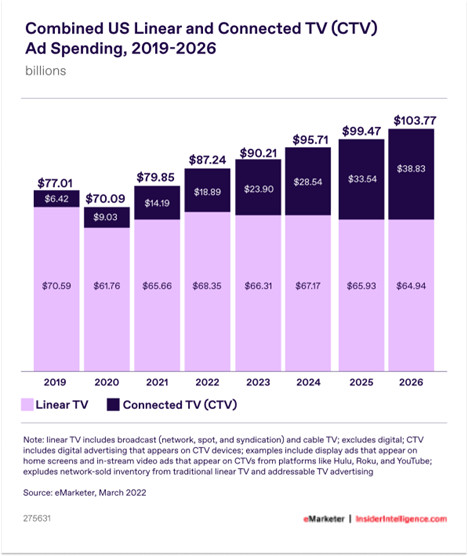The contours of the media landscape are ever-changing. What was once ubiquitous is now far less so. By the end of 2022, 39.3 million US households cut the cord on traditional cable, a number expected to hit nearly 47 million households by the end of 2024.
Perhaps it’s no surprise that so many are saying bye (or never saying hello) to traditional cable with a plethora of streaming services like Netflix, Prime TV, Hulu, Apple TV+, Disney+, and more, which allow viewers to watch what they want, when they want, for less than the cost of a traditional cable subscription.
What is CTV?
In this rapidly shifting landscape, digital marketing is experiencing major change, with Connected TV—or CTV—emerging as a pivotal player, transforming how audiences engage with content. CTV is any television set that connects to the internet and streams digital video content through built-in smart TV functionality or external devices like streaming sticks like Roku, set-top boxes, or gaming consoles.
With this technology, viewers can access a wide range of content that goes far beyond traditional broadcast channels, like streaming services, on-demand video, and internet applications. All of this is causing major shifts in how brands advertise to their audiences, with CTV advertising in ascendancy and changing the TV advertising game. Let’s dig in.
The What and the Why of CTV Advertising
CTV advertising refers to video ads delivered through a streaming service while a viewer watches a TV show, movie, or other video content on an actual TV set via a connected device like Firestick or Roku or directly from a smart TV. For most streaming services, CTV represents over 80% of all viewing, the remainder occurring on other internet-connected devices like laptops, smartphones, and tablets.
Unlike traditional television advertising, CTV advertising leverages viewer data like demographics, viewing habits, and interests, allowing for a more targeted and personalized ad experience. Advertisers gain improved measurement and tracking abilities, allowing for smarter and more efficient ad spending — and the ability to reach more niche audiences with greater precisions.
Evolution of TV Advertising
Traditional or linear TV advertising lets advertisers reach millions of viewers all at the same time. Linear TV advertising is what you see when you watch broadcast or cable TV — the traditional, old-school TV advertising that’s been around for decades. Linear TV ads reach everyone watching a particular program rather than just their intended audience. And measuring the success of a linear TV ad campaign is more nebulous — it’s hard to know if anyone went to go buy something after watching the ad.
With changing viewer behavior as cable and satellite TV use continue to drop, advertisers are instead following their viewers over to CTV, lured by more measurable ad performance metrics and better-optimized campaign management overall. As linear advertising spend declines, CTV ad spend is fast on the rise.
Ad spending for CTV is expected to reach $21.45 billion in 2024, an increase of 16.2% from 2023. In 2025, it is forecast to hit $24.4 billion, growing year over year by 13.9%.

CTV Advertising vs OTT Advertising
OTT means “Over-the-Top,” referring to content that goes “over” your cable box, providing access to TV content via an internet connection instead of with a cable cord or satellite. While OTT and CTV are often used interchangeably, and can refer to the same thing, it’s important to note that OTT is how video content is delivered to viewers — it can stream content across all devices, like mobile and desktop. CTV only streams content onto smart TV screens, which is why it is often referred to as streaming TV advertising.
OTT ad inventory tends to differ from CTV, which typically has premium network content similar to what you would find on traditional TV. In contrast, OTT offers a much wider range of inventory.
So, Why Use CTV ads?
If you want your ads to help you find users who actually want your products or services, CTV ads are the way to go. As streaming services like Hulu and Netflix adjust their pricing models to an ad-supported tiered system that displays more ads to folks on less expensive plans and fewer or no ads to those on higher plans, marketers can now zero in on their demographic with far more precision.
Here are a few other perks that come with CTV ads:
-
Multiple precision targeting methods
With linear TV, targeting is limited to finding shows that best index against ratings — the system network television uses to make programming decisions and to price advertisements. But Nielsens’ typically can only offer broad age and gender demographic metrics, like women 25 – 54 and men 18 – 49. But CTV advertisers can leverage similar digital targeting to Google and Facebook, which means audience segments can be based on everything from income or education level to personal interests and more.
Some of the top CTV targeting options to get familiar with include:
- Geolocation targeting
- Contextual targeting
- Retargeting
- Time-of-day targeting
- Lookalike targeting
-
Hyper-local targeting
With CTV ads, it’s far easier to pinpoint consumers based on their IP address, which means ads can be hyper-localized and served to viewers in far smaller geographic areas than with linear ads. Messaging can be highly customized based on where the viewer is located. For example, a spa with four locations can send the right commercial to the right viewers closest to each location.
-
High Video completion rates
Superior targeting means that CTV ads are far more likely to be truly relevant to those viewing them—which means they are more likely to be interested in the ad and engage with it until completion. Using automatic content recognition technology, or ACR, CTV providers can provide real-time, second-by-second completion rate data, which helps advertisers hone the effectiveness of their marketing campaigns.
-
Detailed attribution measurement and accuracy
CTV ads allow advertisers to measure the effectiveness of their brand campaigns more accurately via conversions — they can see who came to the brand’s website and completed a purchase after viewing an ad. With time and increased data, advertisers can learn what creative worked best and which publishers, dates, times, and other factors had the greatest impact on conversions.
BOTTOM LINE
Marketers, if you want to lead your company’s CTV marketing innovation charge but need help figuring out where to start, Creative Circle can provide the talent and build the teams to help you perfectly craft and precisely target your brand to shine on the TV screen. The media landscape is fast evolving — to succeed, it’s important to prime your business to be in step with the times.



